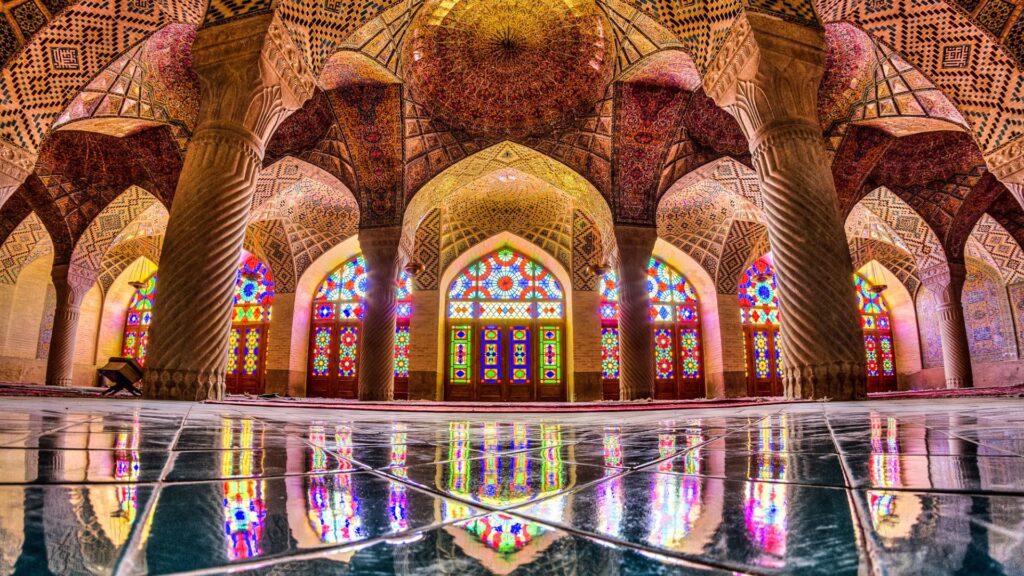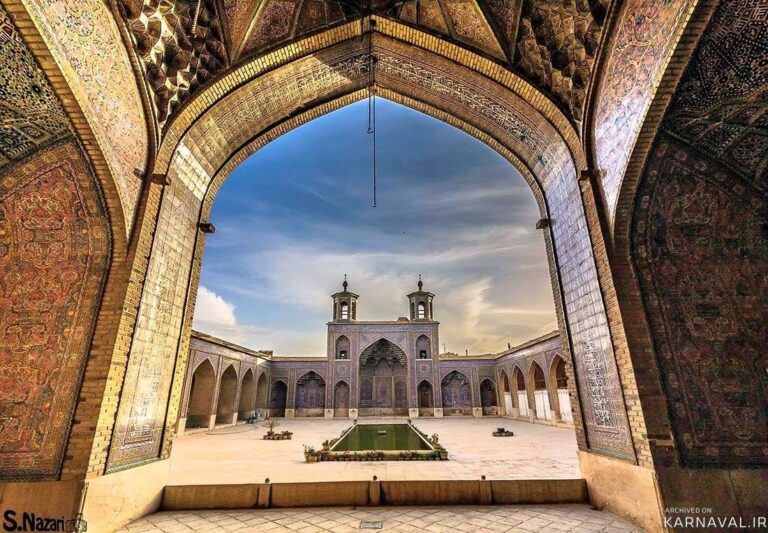
Nasir al-Mulk Mosque, famously known as the “Pink Mosque”, is one of the most breathtaking and unique mosques in Iran, located in Shiraz. This architectural masterpiece was built during the Qajar era and is renowned for its stunning stained-glass windows, intricate tilework, and mesmerizing play of light and colors. The mosque is a true symbol of Persian-Islamic art and craftsmanship, attracting countless visitors from around the world.
History and Construction of Nasir al-Mulk Mosque
This mosque was constructed between 1876 and 1888 by the order of Mirza Hasan Ali Nasir al-Mulk, a wealthy nobleman of the Qajar dynasty. The architect behind this masterpiece was Muhammad Hasan-e Memar, who incorporated traditional Persian architectural elements with innovative artistic details.
Unlike most mosques in Iran, which primarily feature blue tilework, Nasir al-Mulk Mosque is famous for its dominant pink hues, giving it the nickname “The Pink Mosque”. The extensive use of rose-colored tiles and vibrant stained-glass windows makes it one of the most visually captivating religious structures in the world.
Architectural Features of Nasir al-Mulk Mosque
1. Stained-Glass Windows and Light Play
One of the most remarkable aspects of the mosque is its stunning stained-glass windows in the prayer hall. As the morning sunlight passes through these colorful glass panes, it creates a kaleidoscope of colors on the floor and walls, transforming the interior into a surreal and dreamlike space.
2. Exquisite Persian Tilework
The mosque’s walls and ceilings are covered with traditional Persian tilework, featuring intricate floral patterns and a rare dominance of pink and red hues, rather than the usual blue tones seen in most Iranian mosques. This unique feature enhances the warmth and elegance of the mosque’s design.
3. Elegant Muqarnas and Ceiling Decorations
The entrance and interior of the mosque showcase stunning muqarnas (stalactite-like geometric decorations), a hallmark of Persian and Islamic architecture. These elaborate details create a three-dimensional visual effect, adding to the mosque’s beauty.
4. Symmetrical Courtyard and Reflection Pool
The mosque features a traditional Persian courtyard, with a rectangular pool at the center, surrounded by symmetrical archways. This design not only enhances spatial harmony but also allows for stunning reflections of the mosque’s intricate facades in the water.
5. Traditional Iranian Architecture with Qajar Influence
Nasir al-Mulk Mosque follows the classic Persian-Islamic architectural style, incorporating:
- Tall iwans (vaulted halls)
- Richly decorated domes and arches
- Elaborate floral and arabesque motifs
However, its use of color and stained glass sets it apart from other traditional mosques of Iran.
Cultural and Spiritual Significance of Nasir al-Mulk Mosque
Beyond its artistic beauty, the mosque holds deep spiritual significance for the people of Shiraz. It remains a place of worship while also serving as a historical and cultural landmark that showcases the brilliance of Persian craftsmanship.
Thanks to its breathtaking light effects, Nasir al-Mulk Mosque is often described as a “mosque of light and color”, making it one of the most photographed religious sites in the world.
Conclusion
Nasir al-Mulk Mosque, or the Pink Mosque of Shiraz, is a one-of-a-kind architectural wonder, combining traditional Persian design with stunning visual effects. Its masterful tilework, dazzling stained-glass windows, and harmonious structure make it one of the most enchanting historical sites in Iran.


No comments yet.